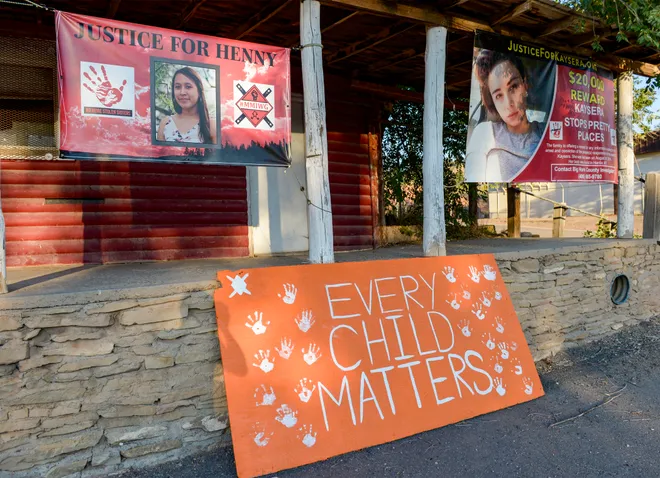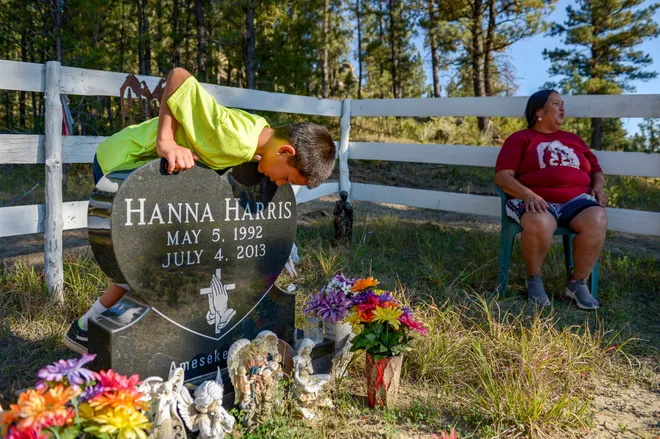Native Americans go missing at alarming rates. Advocates hope a new alert code can help
Native American advocate Loris Taylor gets dozens of social media notifications about missing people every day. After two years of working to get a national alerting system to help bring them home, the CEO and president of Native Public Media finally feels as if that goal is within reach.
The Federal Communications Commission unanimously voted to approve the Missing and Endangered Persons code this month after Indigenous leaders like Taylor spotlighted the need to quickly disseminate information about missing adults. The initiative will enable jurisdictions throughout the United States to alert residents through phones, TV and radio about missing people of all ages – not just children who qualify for AMBER alerts – and spotlight the alarming number of missing Native Americans.
FCC Commissioner Geoffrey Starks wrote in a statement that the new code will close a "critical gap in our public safety infrastructure."
"This three-letter ‘MEP’ event code harmonizes emergency alerts nationwide to ensure that the public is alerted and prepared to respond during these emergencies," Starks said. "Put simply, this Order will help save lives."

In 2023 alone, the FCC said, more than 188,000 adults went missing but didn’t qualify for an AMBER alert because they were 18 or older. FBI data shows about 3,200 of them were Native American, but researchers estimate the true toll is significantly higher.
"Every day when my children are out in the world, I have to sort of take a tabulation at night and say: 'Is everybody where they're supposed to be? Are they home?' And if they're on the road, I can't sleep," Taylor said.
Just in Montana, the state Department of Justice found Native Americans accounted for roughly 25% of reported missing persons but made up 6.6% of the population. A 2023 survey released by the First Nations Development Institute found the biggest concern on Native Americans’ minds was missing and murdered Indigenous women.
“Each time a Native person goes missing, we lose a part of our heritage and culture,” Lavina Willie-Nez, AMBER Alert coordinator for the Navajo Department of Police, testified at an FCC meeting earlier this month.

New code spotlights crisis of missing Native Americans
Native Public Media, a national center that helps tribes secure broadcast facilities, proposed the idea in 2023 to the National Congress of American Indians, which then carried the request to the FCC, Taylor said. After the commission's vote to add the code this month, it will take about one year to implement it across the nation.
There have been sporadic local and state-level efforts to alert for missing adults, but the new MEP code will provide a national, standard alert code so government agencies can coordinate across jurisdictions.
“The MEP event code is just the first step toward that trajectory where we have to have these hard conversations across the country,” Taylor, a member of the Native Hopi Tribe, told USA TODAY.
She said the crisis of missing Native Americans has been “largely neglected.” There is a lot of speculation about why Indigenous people account for a disproportionately high number of missing persons cases. Some tribal communities still have long stretches of dirt road, lack broadband and 911 service, Taylor said, further hindering recovery efforts.
Severely underfunded rescue resources, a knowledge gap in issuing alerts among tribal agencies and lack of centralized data have compounded the disparity, Taylor said.
The Navajo Nation – an 27,400-mile Indigenous reservation across portions of Arizona, New Mexico and Utah – has issued eight AMBER alerts since 2018, the FCC said. All resulted in recovery of the children.
FCC spokesperson Paloma Perez Christie told USA TODAY that several experts have cited “legacies of violence, vulnerability and cultural indifference suffered by Indigenous communities that play a significant role in the disproportionality.”
Black people also vanish at alarmingly high rates, the FCC said. They account for 35% of adult cases, even though they make up about 14% of the U.S. population.

History of missing persons alerts
The AMBER Alert System began in 1996 in the Dallas-Fort Worth area when broadcasters and police collaborated on a system to find abducted children, according to the U.S. Justice Department. It is named after 9-year-old Amber Hagerman, who was kidnapped while riding her bicycle in Arlington, Texas, then killed.
Some states have implemented Silver Alerts for older residents with mental disabilities, but there was no national code, which slows down communication between jurisdictions.
The Ashanti Alert Act, aimed at creating a nationwide communication network to help find missing adults, was signed into law in 2018. The system was named after 19-year-old Ashanti Billie, who vanished in Virginia in 2017. Her body was found two weeks later in North Carolina, according to the Bureau of Justice Assistance.
But the alerts are transmitted through a “patchwork of notification systems” with varying local and state laws, according to a presentation by the FCC’s Office of Native Affairs and Policy this summer. That can cause significant, and potentially disastrous, delays. The new MEP code will provide a national framework for alerts.
Disclaimer: The copyright of this article belongs to the original author. Reposting this article is solely for the purpose of information dissemination and does not constitute any investment advice. If there is any infringement, please contact us immediately. We will make corrections or deletions as necessary. Thank you.




